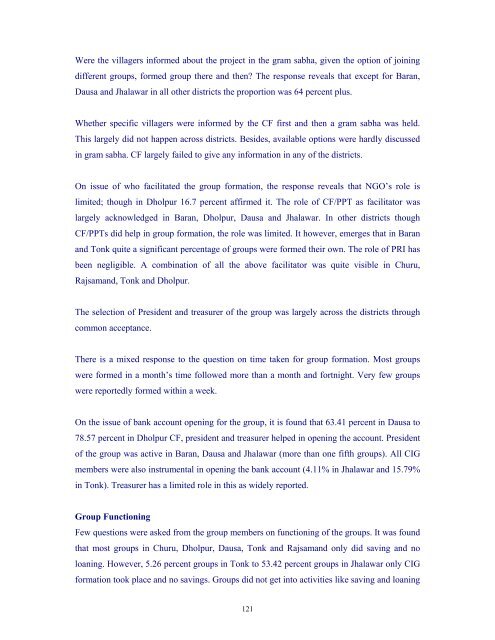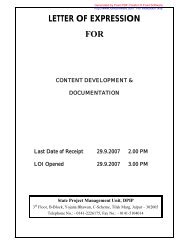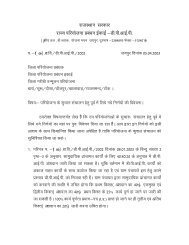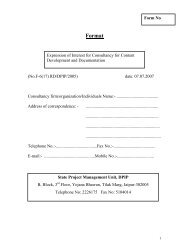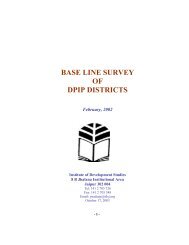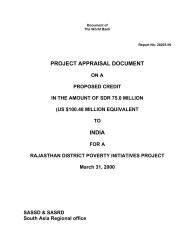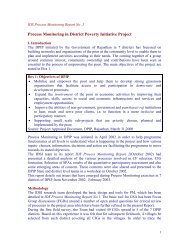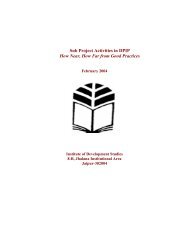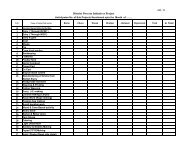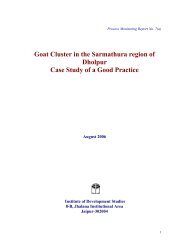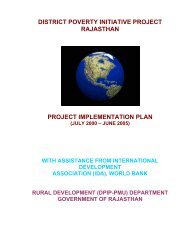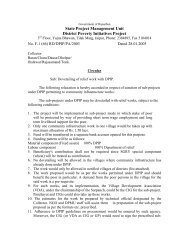Impact Assessment of the District Poverty Initiative Project Rajasthan
Impact Assessment of the District Poverty Initiative Project Rajasthan
Impact Assessment of the District Poverty Initiative Project Rajasthan
Create successful ePaper yourself
Turn your PDF publications into a flip-book with our unique Google optimized e-Paper software.
Were <strong>the</strong> villagers informed about <strong>the</strong> project in <strong>the</strong> gram sabha, given <strong>the</strong> option <strong>of</strong> joining<br />
different groups, formed group <strong>the</strong>re and <strong>the</strong>n The response reveals that except for Baran,<br />
Dausa and Jhalawar in all o<strong>the</strong>r districts <strong>the</strong> proportion was 64 percent plus.<br />
Whe<strong>the</strong>r specific villagers were informed by <strong>the</strong> CF first and <strong>the</strong>n a gram sabha was held.<br />
This largely did not happen across districts. Besides, available options were hardly discussed<br />
in gram sabha. CF largely failed to give any information in any <strong>of</strong> <strong>the</strong> districts.<br />
On issue <strong>of</strong> who facilitated <strong>the</strong> group formation, <strong>the</strong> response reveals that NGO’s role is<br />
limited; though in Dholpur 16.7 percent affirmed it. The role <strong>of</strong> CF/PPT as facilitator was<br />
largely acknowledged in Baran, Dholpur, Dausa and Jhalawar. In o<strong>the</strong>r districts though<br />
CF/PPTs did help in group formation, <strong>the</strong> role was limited. It however, emerges that in Baran<br />
and Tonk quite a significant percentage <strong>of</strong> groups were formed <strong>the</strong>ir own. The role <strong>of</strong> PRI has<br />
been negligible. A combination <strong>of</strong> all <strong>the</strong> above facilitator was quite visible in Churu,<br />
Rajsamand, Tonk and Dholpur.<br />
The selection <strong>of</strong> President and treasurer <strong>of</strong> <strong>the</strong> group was largely across <strong>the</strong> districts through<br />
common acceptance.<br />
There is a mixed response to <strong>the</strong> question on time taken for group formation. Most groups<br />
were formed in a month’s time followed more than a month and fortnight. Very few groups<br />
were reportedly formed within a week.<br />
On <strong>the</strong> issue <strong>of</strong> bank account opening for <strong>the</strong> group, it is found that 63.41 percent in Dausa to<br />
78.57 percent in Dholpur CF, president and treasurer helped in opening <strong>the</strong> account. President<br />
<strong>of</strong> <strong>the</strong> group was active in Baran, Dausa and Jhalawar (more than one fifth groups). All CIG<br />
members were also instrumental in opening <strong>the</strong> bank account (4.11% in Jhalawar and 15.79%<br />
in Tonk). Treasurer has a limited role in this as widely reported.<br />
Group Functioning<br />
Few questions were asked from <strong>the</strong> group members on functioning <strong>of</strong> <strong>the</strong> groups. It was found<br />
that most groups in Churu, Dholpur, Dausa, Tonk and Rajsamand only did saving and no<br />
loaning. However, 5.26 percent groups in Tonk to 53.42 percent groups in Jhalawar only CIG<br />
formation took place and no savings. Groups did not get into activities like saving and loaning<br />
121


